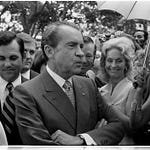
If we are going to have meaningful discussions, we need to realize that there are legitimate points on both sides of issues.
I advocate for dissenting points of view in operational and leadership matters. Dissent drives innovation. Even when we disagree with a position, failing to present it drives groupthink. Groupthink stifles growth.
Discussions about military governance and leadership have to balance civilian oversight with the military’s singular purpose: to protect the nation by achieving national objectives through precise and purposeful application of force.
Should the President dismiss senior military officers who have served honorably?
A “Warrior Board” to Recommend Removal of Unfit Officers
On November 12, the Wall Street Journal (WSJ) published an exclusive article titled, Trump Draft Executive Order Would Create Board to Purge Generals. The Journal received an advance copy of the draft order from an undeclared source. If signed, the order intends to focus military brass “on leadership capability, strategic readiness, and commitment to military excellence.”
The proposed executive order would create a board of retired senior military personnel to review three—and four-star officers and recommend the removal of any deemed unfit for leadership.
On November 13, the WSJ Editorial Board wrote an opinion piece titled Why Trump Wants Hegseth at Defense. The piece rightly identified the nation’s legitimate security issues and stated that military brass needs to be able to focus on their responsibilities and not their political allegiance. The Editorial Board flatly stated the order “would be a mistake that smacks of politicizing the officer corps.”
Critics worry that the order could lead to uncertainty among high-ranking officers. They are concerned that political or ideological alignment would overshadow merit as the criterion for leadership. The same day as the editorial, military.com quoted an unnamed 3-star Army General, who stated, “It could be very hard to do our job if we have to constantly be making sure we're appeasing someone on a political or partisan level.”
This concept of a board to identify and remove unfit leaders isn’t without precedent. Supporters of the draft order point to General George C. Marshall’s plucking boards in 1940. Those boards aimed to streamline leadership and prepare the Army for the high demands of World War II.
Marshall’s approach was driven by his conviction that effective leadership could make or break the Army’s ability to face a global conflict. It was controversial but ultimately successful.
General George C. Marshall and the US Army 1940 Plucking Boards
The great General George C. Marshall became Chief of Staff of the US Army in September 1939. On his first day in office, Germany invaded Poland to kick off World War II.
Twenty years earlier, during World War I, Marshall had observed professionally unfit officers command units with poor results. Military historian Forrest Pogue wrote that Marshall was “haunted by recollections of the droves of unfit commanders” (George C. Marshall, Memoirs of My Services in the World War, 1917-1918 (Boston, 1976), 175-76). Pogue further wrote that Marshall believed he was preparing the Army for war and that it was his duty to the nation to select the right officers for the job. He needed to reform the leadership cadre and ensure the Army was ready for World War II.
Marshall’s plucking boards consisted of six retired officers. They were intended to eliminate officers unfit for command and high rank. He believed swift action was necessary to promote a dynamic set of leaders that would innovate and handle the scale and technology of modern warfare. He recognized that the quality of commanders was crucial as the Army grew and faced more complex missions.
Marshall’s controversial approach prioritized capability over tenure. It aimed to instill a merit-based system that could better adapt to the urgency and unpredictability of wartime demands.
The newly promoted officers played crucial roles in World War II and contributed to American success. The “plucking board” initiative created a more lethal fighting force. Marshall’s boards promoted officers who would go on to shape history. Among them were Dwight D. Eisenhower, the future Supreme Allied Commander Europe and 34th President of the United States; Joseph W. Stillwell, who later commanded all US forces in China, Burma, and India; Omar N. Bradley, the commander of US ground forces during the D-Day invasion at Normandy; and Carl A. Spaatz, the future commander of Strategic Air Forces in the Pacific and the first Chief of Staff of the Air Force.
As Army Chief of Staff, General Marshall conducted his boards using authority delegated by Congressional legislation and existing military regulations. The Selective Training and Service Act of 1940 included provisions that allowed for the rapid expansion and restructuring of the Army as the nation prepared for involvement in World War II.
Advocates for a modern plucking board note the success of Marshall’s approach. Marshall’s review boards retired some senior officers early and selected junior officers with great potential to lead their units to achieve national objectives.
The success of Marshall’s boards highlights how effective civilian oversight, exercised through delegated authority, can transform military leadership. This authority is enshrined in the Constitution, which mandates a framework for civilian control over the military.
The Constitution and Civilian Oversight of the Military
The Constitution establishes civilian control over the military through multiple provisions. These ensure that the armed forces remain accountable to elected leaders rather than independent military authority.
Article II, Section 2 designates the President, a civilian official elected by the people, as the “Commander in Chief of the Army and Navy of the United States.” This gives a civilian elected official the highest military authority and ensures that the military is subordinate to the civilian government rather than acting independently.
At the same time, the Constitution seeks checks and balances. Article I, Section 8 grants Congress the power to raise and support armies, declare war, regulate military forces, and “to make Rules for the Government and Regulation of the land and naval Forces.”
Congress exercises this power through its legislative authority by enacting nearly all laws now codified in United States Code Title 10. These laws serve as the framework for organizing the Department of Defense and each branch of the Armed Forces—the Army, Navy, Marine Corps, Air Force, and Space Force. Additionally, Congress oversees the Coast Guard, which operates under the Department of Homeland Security during peacetime and can be transferred to the Department of the Navy during wartime or by presidential direction. These laws cover a comprehensive range of military operations, including pay grades, enlistments, commissions, promotions, retirements, training, education, recruitment, and honors. This legal structure underscores the essential role of civilian oversight in guiding military standards, ensuring accountability, and keeping the Armed Forces aligned with the nation’s democratic principles and strategic goals.
This framework supports a democratic republic by placing military authority under civilian oversight, preventing military dominance over the government, and protecting against potential abuses of military power.
As Commander in Chief, the President certainly has the authority to direct or conduct boards to review senior officer promotions. The President further has the authority to delegate the conduct of these boards to the service chiefs.
At the same time, Congress has the Constitutional responsibility to control the environment in which officers are raised to senior positions.
Through its structure, the military serves the people as an instrument of national capability directed by civilian leaders. This alignment preserves our democratic republic by ensuring military influence is a part of the elected government and our principles.
With this understanding, the military’s ultimate purpose is to protect and defend the United States, our Constitution, and its people while supporting national interests. The Constitution demands a lethal military under civilian control.
A Continuation of Policy With Other Means
In On War, Carl von Clausewitz famously described war as “a continuation of policy with other means.” Clausewitz was Prussian, and wrote ‘mit anderen Mitteln’ in the original German. He elaborated that we conduct war to compel the enemy to submit to our will. War combines military force simultaneously with other influences, such as diplomacy, to attempt to achieve political objectives.
In short, wartime operations are diplomacy combined with violence.
Military units do not conduct diplomacy.
Therefore, military officers and the units they command aim to achieve efficient violence in service to national objectives.
Since military officers and their units are tasked with achieving efficient violence in service to national objectives, any review of an officer’s conduct must prioritize their capability to fulfill this mission. Other considerations, such as schools attended, advanced academic degrees, and administrative marks, should be secondary. Military leadership should be assessed based on alignment with the Constitution’s mandate to achieve effects supporting national security goals under civilian direction. Military leaders must ensure their units apply force with precision and purpose.
1940 and President Franklin D. Roosevelt
There’s one more question we should ask regarding the proposed boards: Why did President Franklin D. Roosevelt choose to stand aside and not participate in General Marshall’s plucking boards?
FDR didn’t write about the boards, but he trusted General Marshall explicitly.
Roosevelt recognized that diplomacy was not the military component of influence, and he needed to focus on diplomacy. Separating diplomatic and military responsibilities avoids politicizing military decisions while maintaining strategic focus.
FDR focused on diplomatic efforts worldwide, leaving the Army in Marshall's competent hands. Roosevelt engaged in navigating the US response to the growing threat of World War II. He prioritized diplomatic efforts to support the Allies (such as the Lend-Lease program) and prepare the nation for possible involvement in the war.
Roosevelt trusted Marshall to manage the Army's internal restructuring. FDR respected Marshall’s expertise and gave him considerable autonomy to prepare the military for the growing global conflict. Marshall convened the plucking boards under existing Army regulations and legislation, making them a professional and administrative matter rather than a political one.
By allowing Marshall and his boards to operate independently, Roosevelt ensured the process focused on military effectiveness rather than politics.
In Sum
General Marshall’s plucking boards were controversial but successful. They were instrumental in preparing Army leaders for World War II.
The Constitution establishes civilian control over the military. As Commander in Chief, the President has the authority to review and dismiss officers for poor performance. At the same time, Congress is responsible for passing legislation supporting an environment that raises officers to be who the nation needs.
Military officers and their units have a mandate to support and defend the Constitution by achieving efficient violence in service to national objectives.
The military’s strength lies in its unity of purpose, where everyone focuses on the mission. Political affiliation, race, sexual orientation, or any other characteristic should never distract from the ultimate goal: to apply force with precision and purpose in service to our nation.
Senior officer review boards could make sense if they focus on enhancing military effectiveness, ensuring leaders are equipped to support national objectives through precision, readiness, and lethality in the profession of arms. To best achieve this goal, the President should delegate the authority and responsibility of conducting the boards to the service chiefs and leave the task of diplomacy for themselves.
May God bless the United States of America.














Share this post